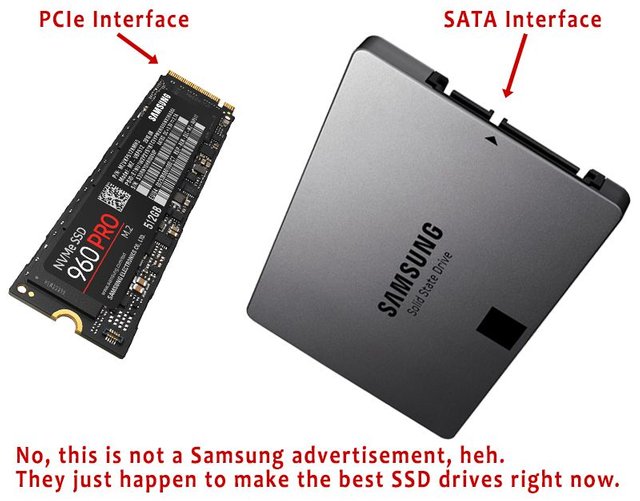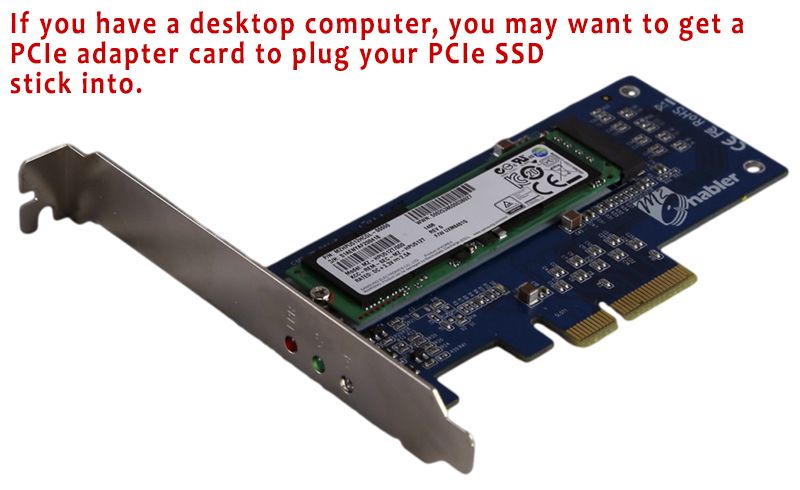Upgrading your computer? Know Your Flavors of Solid State Drive (SSD)
Nowadays if you buy a laptop, the odds are high it has a solid state drive (SSD) instead of a traditional hard disk drive (HDD). Sometimes both.
The first thing we'll do is give brief descriptions of terms so we can get to the meat of helping you decide what to get for your computer.
What is a hard drive (HDD)?
A disk or disks that spin so a "head" can travel to different parts of the disk to read or write data. Hard drives store your programs and data. When you boot up your computer, it is loading the most essential programs, starting with your operating system, into random access memory (RAM) where they can be used.
What is a solid state drive (SSD)?
The most simple explanation is that it is like a bunch of memory that doesn't lose its data when you turn off power. So it delivers the same functionality of a traditional hard drive, though it uses different methods to accomplish data storage.
Differences?
SSDs are faster, lighter, and use less energy. They are also more expensive. How much faster? It mostly depends on the interface.
The interface
This is how the drive talks to the rest of your computer. All modern HDDs use a SATA interface. Many SSDs, especially older ones, use the same interface. The other popular interface is PCI Express or PCIe. Whether you have a HDD or SSD, the speed your computer can access data to/from that drive is limited by the speed of the interface.
Speed
As of late 2017, the data transfer speed on the high end for SSDs of each interface type:
The SATA (version 3) interface ranges from 500 to 750 MB/second.
The PCIe (version 3) interface ranges from 2000 to 4000 MB/second.
Other important things to know before you buy an SSD
- Get NVMe, not AHCI. AHCI is older and was designed for SATA.
- Get M.2, not U.2. M.2 is far more common and it is more likely your computer will support it.
- Get PCIe x4, not PCIe x2. This is the number of "lanes" the drive can utilize, which influences data transfer speed.
- Storage size matters! SSDs wear out. Because of this, the operating system will set aside a portion of your drive for swapping data to keep the wear out as slow as possible. Smaller SSD drives will have less usable space, be slower, and wear out faster. So, if you can afford it, go for 1TB.
- There are two primary form factors for SSDs: One is 2.5", which is about the size of a deck of cards. The other is smaller and flatter, looking very similar to a stick of RAM. The smaller one is where you can get the PCIe form factor. Be careful, though. You can get smaller SSDs in this "stick" format that have the slow SATA interface. Here is an image to show the difference:

EDIT: I left out something important: the image you see here might be misinterpreted to mean if you buy the smaller, "stick" form factor, you will get PCIe. Not true. Both PCIe and SATA3 come in that "stick" form factor.
And if you have a desktop PC, you may need this adapter card:

Where to buy?
I've found the best deals at Amazon.com and NewEgg.com. If you have a Prime account at Amazon, it can make a big price difference. Right now this one is a great deal: https://www.amazon.com/Samsung-960-EVO-Internal-MZ-V6E1T0BW/dp/B01LXS4TY6
Finally, if you already have an SSD in your computer and don't want to open up the case to determine the type you have, you can use Samsung's Magician software to benchmark and tune your drive. http://samsung-magician.software.informer.com/download/
Thanks for reading! Choosing which type of drive you want in your computer can have a huge impact on how fast your computer runs. Depending on what you use your computer for, the other important parts are memory (RAM), processor (CPU), and graphics card. I'll do articles on these items soon.
EDIT: I left out something important: the image you see here might be misinterpreted to mean if you buy the smaller, "stick" form factor, you will get PCIe. Not true. Both PCIe and SATA3 come in that "stick" form factor.
Thanks for this great post
I use the Samsung SSD 850 Pro drive and it's a wonderful drive.
Basti information and picture upload and sharing. Pelese halp my votes
Great post and very informative. Been thinking of getting SSD as they are more reliable than the standard HDD.
@royrodgers has voted on behalf of @minnowpond. If you would like to recieve upvotes from minnowponds team on all your posts, simply FOLLOW @minnowpond.
This comment has received a -16.67 % downvote from @meanpeoplesuck thanks to: @blacklist-a.